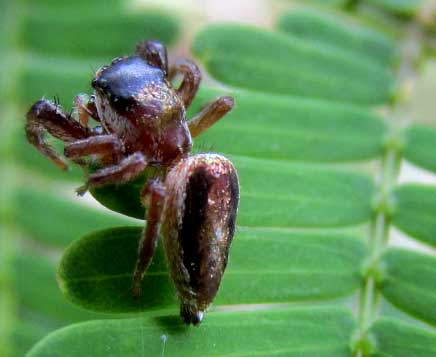Excerpts from Jim Conrad's
Naturalist Newsletter
from the March 27, 2016 Newsletter issued from Hacienda Chichen Resort beside Chichén Itzá Ruins; limestone bedrock; elevation ~39m (~128ft), N20.675°, W88.569°; central Yucatán state, MÉXICO
VEGETARIAN SPIDER
The BBC is working on a documentary film about the Yucatan and for some time one of their researchers, Alec, has been writing to me for background information. The other day Alec mentioned that he'd like to incorporate footage of a "vegetarian spider," Bagheera kiplingi, a Neotropical jumping spider occurring from the Yucatan south to Costa Rica. I'd never heard of the spider, but learned all about it in a paper by Christopher Meehan and others, entitled "Herbivory in a spider through exploitation of an ant-plant mutualism," in a 2009 issue of Current Biology. The paper can be downloaded from http://www.sciencedirect.com/science/article/pii/S0960982209016261
In our area the spider occurs on the Bull-horn Acacia, nicely illustrated on our page at www.backyardnature.net/yucatan/acacia-t.htm
On that page we see the tree's superfluity of swollen-based thorns, and holes in the thorns through which the ants pass who reside inside the thorns. When the tree is disturbed, as by a herbivore grazing on its leaves, the ants rush out and deliver stinging bites, thus defending the tree. The tree reciprocates not only by providing lodging in its thorns but also by producing tiny, yellow "Beltian bodies" at the tips of young leaflets, Beltian bodies being rich in protein, and providing food for the ants. All this has been known for a long time. What's new is the "vegetarian spider" who also feeds on Beltian bodies instead of killing prey. Meehan and his group describe their paper as ".. the first report of a spider that feeds primarily and deliberately on plants."
Upon reading the above article I went to see who might be roaming the leaves of Bull-horn Acacias near the hut. Normally our Bull-horns are leafless at this time of year, but during the last month we've enjoyed three puddle-making rains, so things have greened up surprisingly. I mention this because I've seen Beltian bodies only on newly emerging leaves after good rains. Maybe after our recent rains the Bull-horns would bear some new leaves with Beltian bodies.
The first Bull-horn Acacia I checked bore no new leaves or Beltian bodies, and only a few ants wandered among thorns and few remaining older leaves. The second tree, however, in a shadier environment and with the ground around it covered with moisture-conserving leaf litter, was indeed producing a few new leaves, and the leaflets bore tiny, egg-shaped, orangish-yellow Beltian bodies. Moreover, hundreds of ants swarmed all over the tree, and some were harvesting Beltian bodies, as you can see below:

Meehan's paper says that in the Yucatan the ant species his group had seen harvesting Beltian bodies was Pseudomyrmex peperi, and I assume that that's what we're seeing in the picture. To help with identification, a side view of an ant scurrying away carrying a Beltian body is shown below:

I had hardly hoped to find the "vegetarian spider," Bagheera kiplingi, but lo and behold a jumping spider turned up on a leaf right before my face, shown below:

Was this the vegetarian? Later I'd see that it was similarly structured but differently colored than those in pictures of the species on the Internet, though it almost matched some pictures. The species is known to be variable so I'm thinking that this is indeed the "vegetarian spider," Bagheera kiplingi, though I can't be for sure.
Meehan's paper says that the diet of spiders studied in the Yucatan consisted of about 91% Beltian bodies, though in Costa Rica only about 60%. They supplemented Beltian bodies with nectar from glands at the base of acacia leaves (shown on our Bull-horn Acacia page), plus they occasionally abandoned their vegetarianism and preyed on larvae of the acacia ants, as well as small, nectar-feeding flies, and (rarely) other "vegetarian spiders" smaller than themselves. On a second visit to the tree I didn't see the spider in our photo, but there was another jumping spider, much smaller and pale yellow, which I thought might be an immature "vegetarian spider."
It's hard for me to envision the spiders preying on the ants' larvae because the spider I watched spent a lot of time avoiding the ants. I didn't see the spider feed on Beltian bodies, or even get close to the smaller, ant-infested leaves bearing the bodies.
One final note about this amazing spiny-acacia/ Beltian-body/ ant/ spider relationship is that, at least in our area, yet another species seems to be involved. Every Bull-horn Acacia I've seen lately bears at least one melon-sized paper-wasp nest, the wasps obviously choosing the acacia's spiny branches over non-spiny ones.
I guess that the benefit to the wasp is that small animals are less likely to climb a spiny tree to feed on the wasps' larvae. However, what about the larva-eating disposition of the "vegetarian spider," and possibly of the acacia ants themselves? We've documented marauding army ants robbing a paper-wasp nest of its larvae, at www.backyardnature.net/yucatan/ant-wasp.htm
Meehan and his group have described a very interesting web of relationships centering around the Bull-horn Acacia, but maybe the web is even more intricate and surprising than his paper documents.